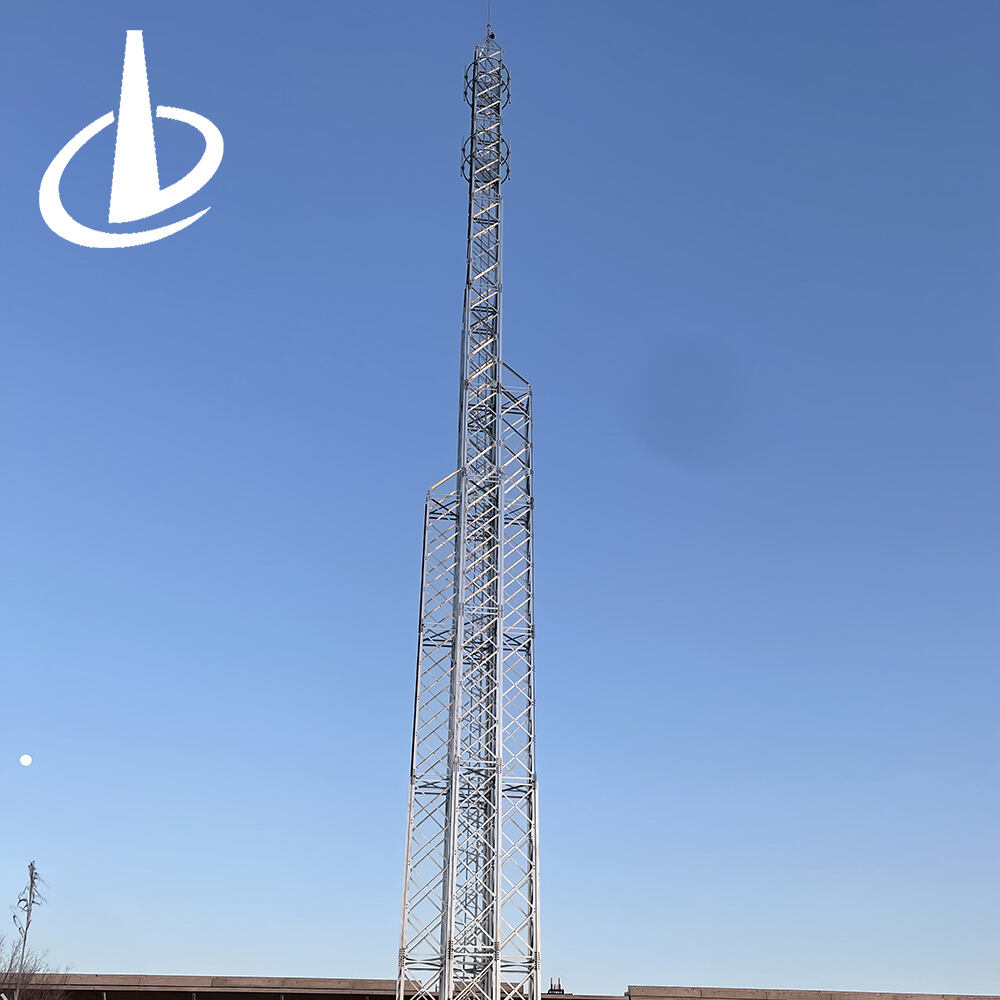Einführung
Kommunikationsturme sind zum Rückgrat moderner Vernetzung geworden. Sie ermöglichen Ihnen schnelleres Internet und unterbrechungsfreie Kommunikation. Diese Türme sorgen für eine zuverlässige Signalübertragung, auch in abgelegenen Gebieten. Durch die Unterstützung fortschrittlicher Technologien helfen sie Ihnen, in Verbindung zu bleiben und Zugang zu kritischen Diensten zu erhalten, und verändern so Ihre Interaktion mit der Welt.
Die Rolle von Kommunikationstürmen in der modernen Vernetzung
Was sind Kommunikationsmaschinen?
Kommunikationsturme sind hohe Strukturen, die Antennen und andere Kommunikationsgeräte unterstützen. Diese Türme spielen eine entscheidende Rolle bei der Übertragung von Signalen für Mobiltelefone, Fernsehen, Radio und Internetdienste. Sie können sie in verschiedenen Formen sehen, wie z. B. Gittertürme, Monopole oder mastenförmige Masten. Jede Art dient einem bestimmten Zweck, der sich auf den Ort und die Art der Kommunikation stützt, die sie unterstützt.
Diese Türme sind oft aus Stahl oder Stahlbeton gefertigt, um schwierigen Wetterbedingungen standzuhalten. Sie sind strategisch positioniert, um die Abdeckung zu maximieren und eine zuverlässige Konnektivität zu gewährleisten. Ohne diese Türme würden moderne Kommunikationssysteme schwer funktionieren.
Wie Kommunikationsturme die Übertragung von Signalen ermöglichen
Kommunikationsturme arbeiten durch die Übertragung und Empfang von elektromagnetischen Signalen. Antennen, die auf den Türmen montiert sind, senden Signale an Ihre Geräte, wie Smartphones oder Computer. Diese Signale bewegen sich durch die Luft als Radiowellen. Wenn Sie telefonieren oder im Internet surfen, sendet Ihr Gerät ein Signal an den Tower zurück und vervollständigt so die Kommunikationsschleife.
Die Höhe des Turms sorgt dafür, daß Signale lange Strecken ohne Hindernisse zurücklegen können. Diese Konstruktion verringert die Störungen und verbessert die Qualität der Verbindung. Durch die nahtlose Übertragung von Signalen halten Sie Kommunikationstürme mit der digitalen Welt verbunden.
Erweiterung der Vernetzung in städtischen und ländlichen Gebieten
Kommunikationsturme überbrücken die Kluft zwischen städtischen und ländlichen Gebieten. In Städten verarbeiten sie hohe Datenmengen und sorgen für schnelle und zuverlässige Verbindungen. In ländlichen Regionen bringen diese Türme die Anbindung an Orte, an denen die traditionelle Infrastruktur begrenzt ist.
Vielleicht bemerken Sie, daß ländliche Türme oft höher sind, um größere Flächen mit weniger Anlagen zu bedecken. Dieser Ansatz trägt dazu bei, Internet- und Mobilfunkdienste für unterversorgte Gemeinden zu erweitern. Durch die Erweiterung der Vernetzung ermöglichen Kommunikationsmasten Menschen in abgelegenen Gebieten Zugang zu Bildung, Gesundheitsversorgung und wirtschaftlichen Möglichkeiten.
Kommunikationsmasten und die 5G-Revolution
Anpassung der Türme an die 5G-Technologie
Sie fragen sich vielleicht, wie sich Kommunikationstürme entwickeln, um 5G zu unterstützen. Diese Türme müssen modernisiert werden, um die Anforderungen dieser fortschrittlichen Technologie zu erfüllen. Die Ingenieure installieren neue Antennen und Geräte, um schnellere Datengeschwindigkeiten und geringere Latenzzeit zu ermöglichen. Diese Upgrades stellen sicher, dass Ihre Geräte nahtlos mit dem 5G-Netzwerk verbunden werden können.
Bestehende Towers werden häufig strukturell geändert, um dem zusätzlichen Gewicht der 5G-Hardware gerecht zu werden. In einigen Fällen werden neue Türme gebaut, um die Lücken zu schließen. Diese Änderungen sorgen dafür, dass 5G-Signale mehr Gebiete erreichen und Ihnen eine bessere Benutzererfahrung bieten.
Die Bedeutung höherer Frequenzbänder
die 5G-Technologie setzt auf höhere Frequenzbänder wie Millimeterwellen, um schnellere Geschwindigkeiten zu liefern. Diese Bande können mehr Daten transportieren, haben aber eine kürzere Reichweite. Kommunikationsmaschinen spielen eine entscheidende Rolle bei der Überwindung dieser Einschränkung. Durch die Annäherung der Towers sorgen Ingenieure dafür, dass die 5G-Signale stark und zuverlässig bleiben.
Vielleicht bemerken Sie in städtischen Gebieten kleinere Türme oder "kleine Zellen". Diese Strukturen arbeiten neben traditionellen Türmen, um die Signalstärke zu erhöhen. Diese Anlage sorgt dafür, dass Sie auch an überfüllten Orten eine unterbrechungsfreie Verbindung genießen können.
Innovationen in der Turminfrastruktur für 5G
Innovationen im Tower-Design verändern die Funktionsweise von 5G-Netzwerken. Ingenieure entwickeln leichte Materialien und modulare Bauweisen, um die Leistung der Türme zu erhöhen. Einige Türme integrieren nun erneuerbare Energiequellen, wie z. B. Solarzellen, um die Umweltbelastung zu reduzieren.
Intelligente Türme mit Sensoren überwachen die Leistung und erkennen Probleme in Echtzeit. Diese Fortschritte sorgen dafür, daß die Kommunikationsmaschinen zuverlässig und effizient bleiben. Dadurch profitieren Sie von schnelleren und zuverlässigeren Verbindungen.
Weltweite Auswirkungen fortschrittlicher Kommunikationsmasten
Überbrückung der digitalen Kluft in abgelegenen Gebieten
Kommunikationstürme spielen eine wichtige Rolle bei der Verbindung entlegener Gebiete mit der digitalen Welt. An Orten, an denen die traditionelle Infrastruktur knapp ist, bringen diese Türme Internet- und Mobilfunkdienste an unterversorgte Gemeinden. Sie können sehen, wie diese Vernetzung Leben verändert, indem sie den Zugang zu Online-Bildung, Telemedizin und E-Commerce ermöglicht.
In abgelegenen Gebieten bedecken höhere Türme größere Flächen und verringern so die Notwendigkeit mehrerer Anlagen. Dieser Ansatz stellt sicher, dass selbst die abgelegensten Dörfer mit dem globalen Netzwerk verbunden werden können. Durch die Überbrückung der digitalen Kluft ermöglichen Kommunikationsmasten den Einzelnen, an der modernen Wirtschaft teilzunehmen und ihre Lebensqualität zu verbessern.
Revolutionäre Industrie durch Vernetzung
Die Industrie setzt auf Kommunikationstürme, um im heutigen digitalen Zeitalter effizient zu arbeiten. Die Landwirtschaft profitiert beispielsweise von intelligenten Landwirtschaftstechnologien, die von einer zuverlässigen Vernetzung abhängen. Sie haben vielleicht bemerkt, wie Bauern Sensoren und Drohnen verwenden, um die Ernte zu überwachen und die Erträge zu optimieren.
Im Produktionssektor unterstützen Kommunikationsturme die Automatisierung und Echtzeitüberwachung von Produktionslinien. Gesundheitsversorgungseinrichtungen nutzen diese Netzwerke, um Telemedizindienste zu ermöglichen und kritische Daten auszutauschen. Kommunikationstürme treiben Innovationen voran und verbessern die Produktivität, was Unternehmen hilft, in einer vernetzten Welt zu gedeihen.
Wirtschaftliche und soziale Vorteile von Kommunikationstürmen
Die Anwesenheit von Kommunikationstürmen fördert die lokale Wirtschaft. Sie schaffen Arbeitsplätze bei Bau, Instandhaltung und Betrieb. Sie könnten auch beobachten, wie verbesserte Vernetzung Unternehmen in ländliche Gebiete anzieht und so das Wirtschaftswachstum fördert.
Sozial verbessern diese Türme die Kommunikation und den Zugang zu Informationen. Menschen können mit ihren Angehörigen in Kontakt bleiben, Zugang zu staatlichen Dienstleistungen haben und an Online-Communities teilnehmen. Durch die Unterstützung der wirtschaftlichen und sozialen Entwicklung tragen Kommunikationsmasten zu einer integrativeren und vernetzteren Gesellschaft bei.
Kommunikationstürme treiben die Entwicklung globaler Netzwerke voran. Sie ermöglichen eine schnellere, zuverlässigere Verbindung, die die Art und Weise verändert, wie Sie mit der Welt interagieren.
Die Erweiterung der 5G-Technologie unterstreicht ihre Bedeutung für die moderne Kommunikation.
Sie profitieren von einem verbesserten Zugang in unterversorgten Gebieten, der die digitale Kluft überbrückt. Mit fortschreitender Technologie werden diese Türme weiterhin die globale Innovation und Vernetzung beeinflussen.

